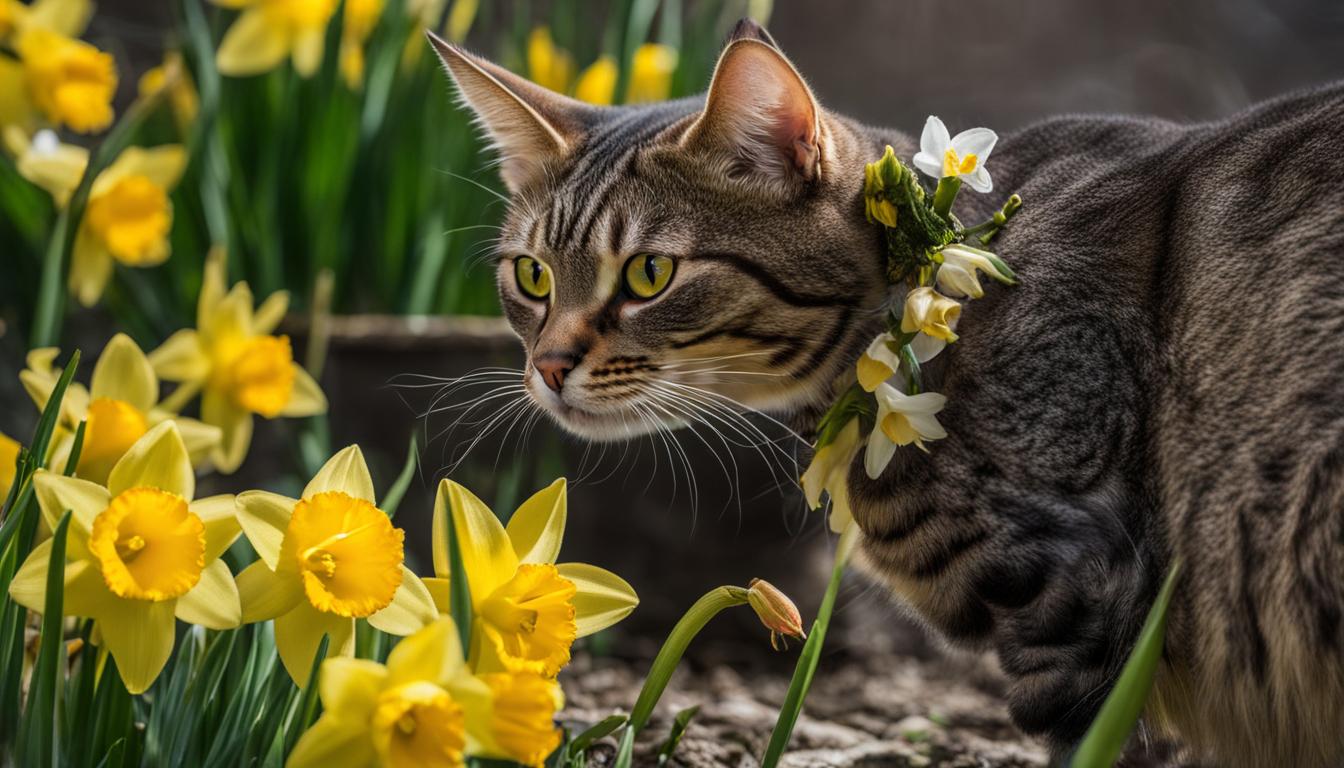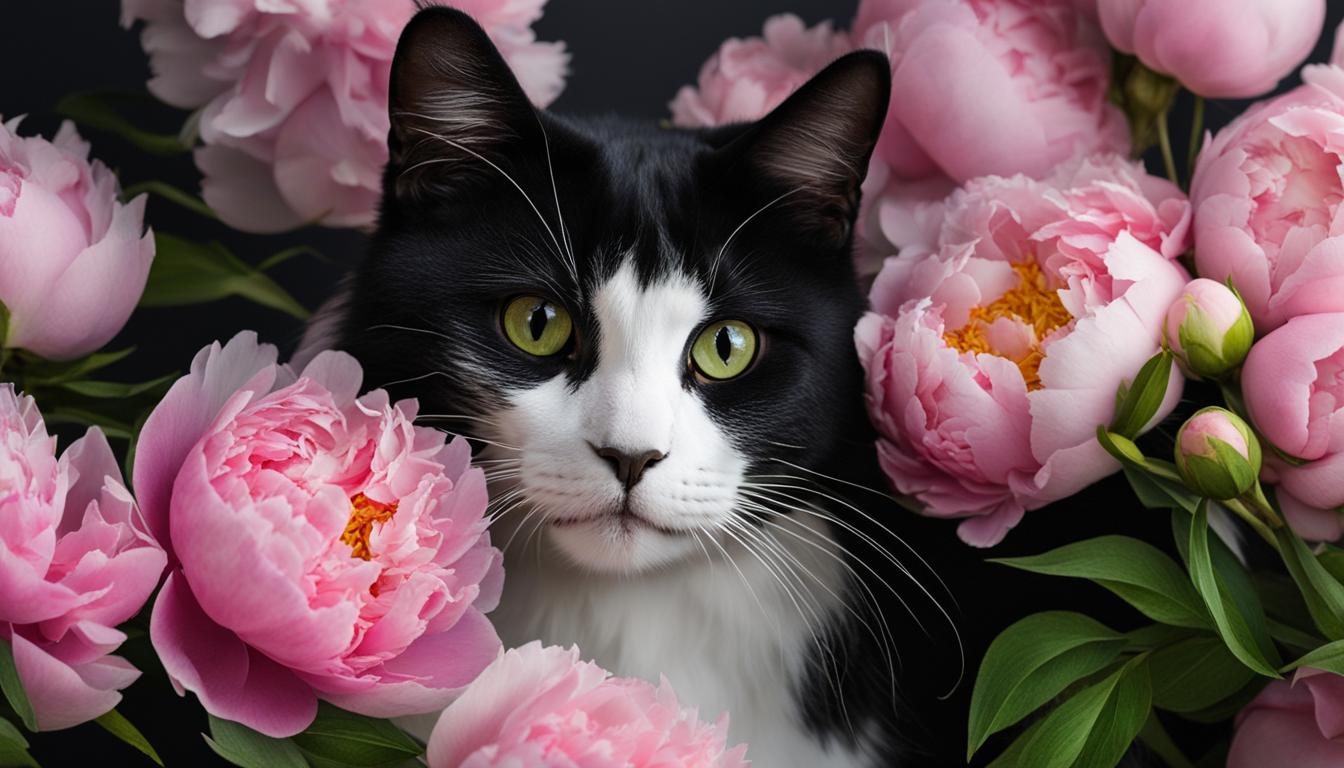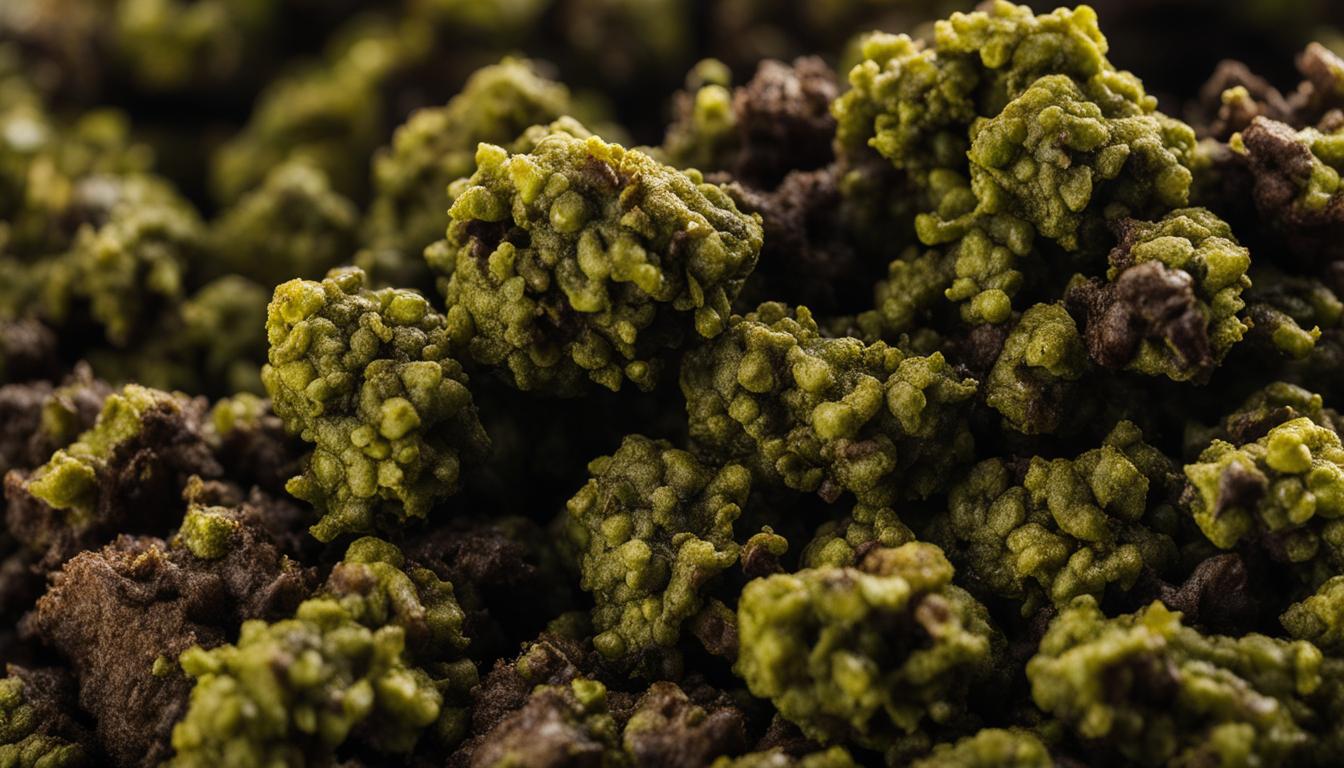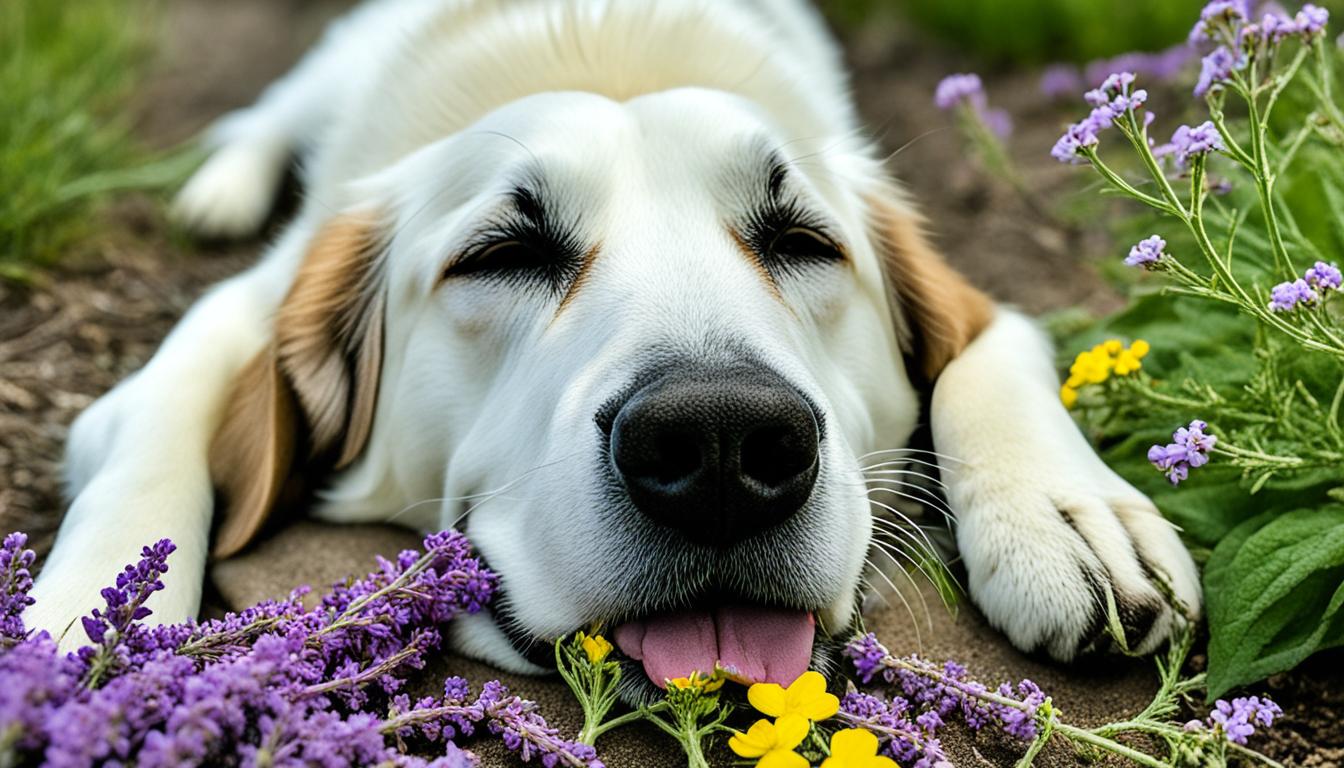As the bloom of spring approaches, gardens across the United Kingdom are adorned with the cheerful hues of Narcissus flowers. While these plants, including various daffodils, add allure to your greenery, they harbour a hidden danger to our feline companions. It is essential for pet owners to be informed about the safety of these popular plants. The question of whether Narcissus are poisonous to cats is a matter of significant concern. With compounds like lycorine present in these flowers, cat safety becomes a priority when Narcissus and daffodils and cats coexist in the same environment.
Cultivating an awareness of the potential hazards associated with Narcissus flowers is an essential facet of pet care. Identifying symptoms of toxicity and taking preventative measures can help ensure a safe space for your beloved cats to explore and enjoy.
Key Takeaways
- Narcissus plants contain lycorine, an alkaloid with emetic properties that is toxic to cats.
- Ingestion of any part of a Narcissus plant can cause severe symptoms in cats, such as vomiting and diarrhoea.
- Owners should be vigilant about keeping flowers like daffodils out of reach of cats to ensure safety.
- The bulbs of Narcissus plants are especially hazardous and can lead to critical health issues if ingested by cats.
- Immediate veterinary attention is required if a cat is suspected of ingesting any part of a Narcissus flower.
The Toxicity of Narcissus to Feline Friends
For those who revel in the delight of flowering bulbs, the striking appearance of Narcissus flowers is often a garden highlight. However, for feline owners, the allure of these plants is overshadowed by a significant risk to their furry companions. Narcissus ingestion in cats is an issue of grave concern, given the considerable toxic properties of these common garden beauties.
Understanding Lycorine and Its Emetic Effects on Cats
At the heart of Narcissus toxicity in cats lies lycorine, an alkaloid with potent emetic properties. This substance is found throughout the plant but is most concentrated in the bulbs. When a curious cat chews on any part of a Narcissus, the lycorine swiftly provokes a response—leading to vomiting, one of the primary symptoms of Narcissus poisoning in cats. This immediate reaction, while distressing, can serve as a natural defence mechanism, potentially minimising the absorption of further toxins.
Symptoms of Narcissus Poisoning in Cats
The initial symptoms of Narcissus ingestion in cats may seem benign, but they can quickly escalate to more threatening conditions. Pet owners should watch for signs such as:
- Drooling and nausea, which often precede vomiting
- Diarrhoea, as the gastrointestinal tract reacts to the irritation
- An increased heart rate, reflecting systemic distress
- Abdominal pain and difficulty breathing, indicating a severe reaction
- Possible cardiac arrhythmias, which can be life-threatening
The onset of these symptoms necessitates prompt veterinary care to mitigate the effects of toxicity and prevent potential long-term health issues.
Identifying High-Risk Parts: Bulbs, Plants, and Flowers
Though it may seem that just the bulbs are dangerous, it is essential to recognise that the entire plant poses a threat. However, the toxicity of narcissus to cats spikes significantly when bulbs are involved. Are narcissus dangerous for cats? Absolutely. Ingestion of bulbs brings with it a higher dose of toxins, leading to:
- Low blood pressure and heart rhythm abnormalities
- Respiratory depression, which can severely impact breathing
- Neurological effects, such as ataxia, tremors, and seizures
The beauty of Narcissus belies its potential danger. Awareness and prevention are crucial for cat owners to ensure the safety and well-being of their cherished pets.
Are Narcissus Poisonous to Cats?
Whether enhancing gardens or brightening up homes, narcissus flowers, particularly daffodils, are a sight to behold. However, their beauty belies the danger they pose to our feline companions. Questions such as “Can cats be harmed by narcissus?” and “Are daffodils poisonous to cats?” are concerns that require immediate attention.
On ingestion, these ornamental plants can result in a suite of toxic reactions. The primary offending agents, calcium oxalate crystals, stimulate intense oral irritation leading to excessive drooling and severe gastrointestinal pain in our feline friends. The presence of phenanthridine alkaloids compounds the problem, potentially triggering serious gastrointestinal distress, hypotension, and even life-threatening respiratory concerns.
The ubiquitous nature of these plants during springtime makes it essential for cat owners to remain vigilant. The risk to pets is not merely hypothetical; cases of toxic exposure are well-documented in veterinary literature. It is paramount that cat carers identify and mitigate the risks associated with these common yet hazardous blooms.
- Immediate isolation from the plant.
- Monitoring for symptoms of distress.
- Rapid consultation with a veterinarian.
Toxicity concerns are not solely limited to nibbling on a fresh bouquet. Discarded plant bulbs and water from a vase containing narcissus can be equally harmful. Cat owners should be cautious of placing these tempting objects in areas accessible to their curious companions. Let us show due diligence in guarding our pets against these deceptive dangers and ensuring peace of mind for all concerned.
Cat Safety and Narcissus Flowers: Prevention and Protection Strategies
Feline owners who cherish both their pets and their gardens face the challenge of creating a safe garden for cats. To prevent toxic exposure, cats and narcissus plants should not share the same space. In this section, we’ll explore effective strategies to safeguard your beloved cat from the dangers posed by these and other toxic flora both outdoors and indoors.
Creating a Pet-safe Garden: Plants to Avoid
Securing your garden to make it friendly for feline exploration means identifying and avoiding particular plants that can cause harm. Here’s a list of plants owners should steer clear of:
- Narcissus (Daffodil)
- Japanese Yew
- Azaleas
- Rhododendrons
- Lily of the Valley
- Oleander
Steering away from these toxic houseplants to cats will significantly reduce health risks for your curious companions.
Indoor Hazards: Toxic Houseplants and Cat Accessibility
Not only outdoor gardens pose risks but indoors too, many common houseplants prove to be indoor hazards for cats. Lilies from the Lilium and Hemerocallis species are especially hazardous and can lead to acute kidney failure if ingested by cats.
Immediate Actions to Take if Your Cat Ingests Narcissus
If the unfortunate happens and your cat ingests part of a narcissus plant, prompt actions are needed. Below is a guide detailing what to do if a cat ingests narcissus:
| Action | Explanation |
|---|---|
| Remove any plant fragments from the cat’s mouth | This helps to minimize the ingestion of more toxins. |
| Observe the cat for any symptoms | Watch for signs of discomfort, drooling, or changes in behaviour. |
| Seek Immediate veterinary care for cat poisoning | Professional help can mitigate the effects of the poison. |
| Consult a poison helpline if needed | They can provide additional, immediate advice on how to proceed. |
By remaining vigilant and prepared to act, cat owners can ensure the safety of their pets from the risks of toxic plants like narcissus.
Conclusion
In summarising our discussion, it’s crucial for pet owners to realise the dangers that narcissus plants, including daffodils, pose to our feline companions. Understanding the potentially toxic daffodil and cat interactions is essential to prevent accidental poisoning. Due to the appealing nature of these plants, they may attract the curious tendencies of cats, inevitably placing them at risk. Awareness and proactive prevention are the hallmarks of responsible pet ownership to avoid the ensuing health hazards to cats.
Understanding the Seriousness of Daffodil and Cat Interactions
The risks associated with the ingestion of narcissus plants by cats cannot be overstated. Lycorine, the toxic compound found in these plants, can induce a range of symptoms from mild gastrointestinal upsets to life-threatening cardiac conditions. Knowledgeable pet owners should recognise narcissus plant hazards to cats and take steps to ensure that their homes and gardens are free from such perilous flora.
The Importance of Swift Veterinary Care for Poisoning
Swift veterinary care for cat poisoning is imperative. In the unfortunate event that a cat does ingest any part of a daffodil or other narcissus plants, time is of the essence. Immediate veterinary intervention can significantly improve the prognosis by promptly addressing symptoms and initiating appropriate treatment. This underpins the importance of vet care for poisoned cats, which not only offers the best chance for a full recovery but also spares them from undue suffering. Cat owners should remember these guidelines to safeguard their pets’ well-being.
FAQ
Are Narcissus Poisonous to Cats?
Yes, narcissus plants are poisonous to cats. They contain lycorine and other toxic compounds that can lead to vomiting, gastrointestinal upset, and more severe symptoms such as cardiac arrhythmias and respiratory depression if ingested by cats.
What are the Symptoms of Narcissus Poisoning in Cats?
Symptoms of narcissus poisoning in cats include drooling, vomiting, diarrhea, increased heart rate, abdominal pain, lethargy, difficulty breathing, convulsions, and possibly cardiac arrhythmias if a significant amount has been ingested.
Can Cats be Harmed by Simply Being Around Narcissus Plants?
While simply being around narcissus plants does not necessarily harm cats, the risk arises when they chew on or ingest any part of the plant. Even small amounts can be harmful, so it is important to keep these plants out of reach.
What Parts of the Narcissus Plant are Most Dangerous to Cats?
The bulbs of the narcissus plant are the most toxic part to cats due to a higher concentration of lycorine and other harmful substances. It is crucial to ensure that bulbs are not accessible to your cat.
How Can I Keep My Cat Safe from Narcissus and Other Toxic Plants?
To keep your cat safe, avoid planting narcissus and other toxic plants in areas your cat can access. Indoors, place potentially dangerous houseplants out of reach, and consider choosing cat-safe alternatives for your home and garden.
What Should I Do if My Cat Ingests Narcissus?
If you suspect that your cat has ingested narcissus, immediately remove any plant fragments from your cat’s mouth, rinse their mouth gently with water, and contact your veterinarian or an emergency pet poison helpline. Timely veterinary intervention is crucial.
What Makes Lycorine in Narcissus Plants Toxic to Cats?
Lycorine, an alkaloid found in narcissus plants, is toxic because it has strong emetic properties that can lead to severe gastrointestinal upset when ingested. Its ingestion results in the body’s attempt to expel the toxin through vomiting.
Are Daffodils Specifically Hazardous to Cats?
Yes, daffodils, a popular type of narcissus, are hazardous to cats. They contain the same toxic substances as other narcissus varieties and can cause similar symptoms of poisoning.
Can Indoor Cats Be at Risk from Narcissus Plants?
Indoor cats can still be at risk if they are able to access narcissus plants kept within the home. It’s essential to eliminate these toxic plants from your indoor environment or ensure they are completely inaccessible to your cat.
How Quickly Should I Seek Veterinary Care if My Cat has Poisoning Symptoms?
Immediate veterinary care is critical if your cat shows any signs of poisoning. The sooner a cat is treated, the better the chances of recovery. Do not wait for symptoms to resolve on their own, as this can lead to more severe health issues.







